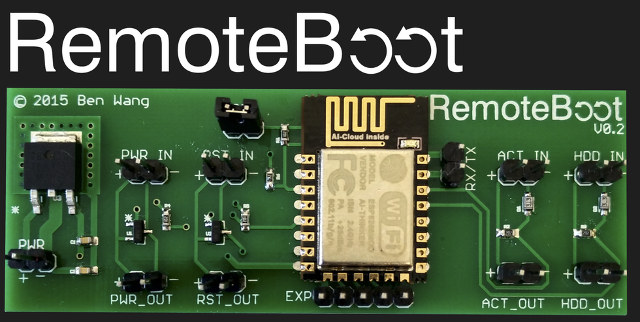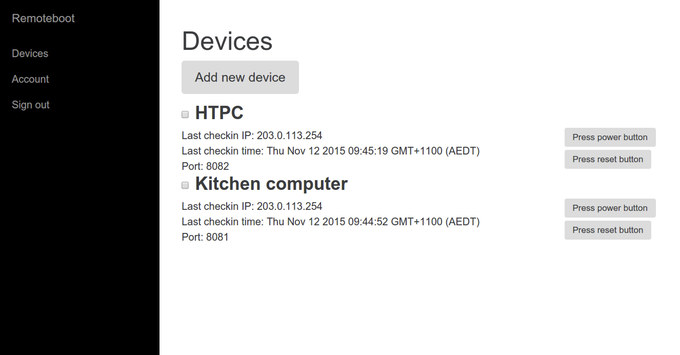Wake-on-LAN is a features that allows you to remotely start your computer by sending magic network packets to the LAN interface, but it requires support from your motherboard. So Ben Wang, an Australian high-school student, decided to make his own little board called RemoteBoot to power off and reboot computers that do not support the feature, or even access the serial console on embedded boards.
The board is pretty basic and includes an ESP8266 module:
- ESP12-E WiFi module
- 2x digital switching outputs for power and reset buttons
- 2x digital protected inputs for power and activity LEDs
- 3x extra general purpose inputs/outputs broken out
- Tx/Rx for serial console
There’s also a feature disabled by default, where a watchdog monitor the activity LED, and automatically reboots the computer after a user-defined timeout.
Everything will be control via a simple web interface, and if you have multiple RemoteBoot devices, access to Remoteboot Cloud will allow managing all these devices individually. Documentation for the board, e.g. how to install it, and source code are currently nowhere to be found.
RemoteBoot is now on Kickstarter, and already funded, but it has not exactly been optimized for cost, as you’ll need to pledge $25, plus $5 shipping to get the device in April 2016.
Via Phoronix

Jean-Luc started CNX Software in 2010 as a part-time endeavor, before quitting his job as a software engineering manager, and starting to write daily news, and reviews full time later in 2011.
Support CNX Software! Donate via cryptocurrencies, become a Patron on Patreon, or purchase goods on Amazon or Aliexpress







Meh expensive and of moderate use. I could probably just do a wake on LAN or something like that instead.
Really pricey for what it does. I wonder how the board is powered, I don’t see any USB connector for example which could provide the 5V input to the PWR pins. And for that price, you should be able to have a decent RS232 12V serial converter, even if most PCs do not have a serial connector anymore.
Only some servers BIOSes can output text serial console (or at if you are lucky to have a running coreboot).
Congratulations, For making the most useless device of the year 2015 😀
Really? I find this quite interesting as any RPB (Remote Power Boot) device is quite expensive and the cheaper ones require serial interface and only the very very expensive ones are accessible over the network. Think several hundreds to thousands depending on the port density. The one I currently have is standard power cable external to the machine and is a PITA to serial into with minicom on my linux box just to reboot another device.
This would allow one to put a cheap $25 card in a system that allows you to reboot a device remotely over the network when it is hung or halted instead of rebooted. I am intrigued!
And I don’t think WOL supports rebooting a device that is already up, or hard powering a device that is hung; it only supports turning on a device that is off. THAT is a clear example of moderate use.
I made a feature-limited (no cloud and whatnot) open-source version of this: https://github.com/festlv/esp-power-control
@Abdullbasit
You said: “Congratulations, For making the most useless device of the year 2015”
So what did you accomplish in high school my friend Abdullbasit?
I think this is a great tool ! Just because it isn’t a tool that you may need in your tool chest, doesn’t mean others may not find a necessity for it. I work in an industry where remote watchdog devices need to be installed in legacy devices all the time, and this tool is the cheapest price solution you can get to have a remote relay with monitoring / watchdog capabilities..
I have a use for it right now, in a remote situation where it can prevent a truck-roll anytime my device needs to be power cycled. Will save gas so you don’t have to drive 20 miles to power cycle, not to mention the downtime where customers service goes down in the time it takes to go out there and reboot..
Don’t crack on the kid for being a genius!
.